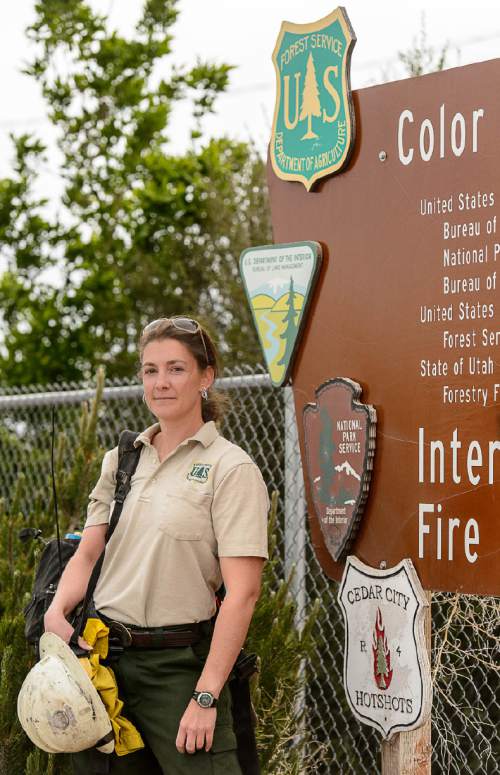This is an archived article that was published on sltrib.com in 2016, and information in the article may be outdated. It is provided only for personal research purposes and may not be reprinted.
When Megan Saylors heard a speaker at her high school describe wildland firefighting, it didn't sound like a job she wanted to pursue.
That would change.
In college, the pre-med student landed a summer job clerking at a U.S. Forest Service station. The office work was too easy; she hated it. But as firefighters stopped by, swapping adventure stories about the great outdoors and radiating the kind of camaraderie that is forged in fire, Saylors started to question her first impressions about the profession.
A few years later, Saylors was flying into Arizona to help wrestle control over an inferno. In the end, she helped guide nature in its restorative work and protected a corner of the world from unintended consequences.
It all "really ties back into 'the greatest good for the greatest number in the long run,' " Saylors said recently from the Cedar City station for Utah's Dixie National Forest, quoting the Forest Service's founding philosophy like an oath.
It's an oath shared by few female firefighters.
Generally, women make up no more than 10 percent of the Forest Service's wildland firefighters in Utah. Numbers for the rest of the country are in the same ballpark.
A few years ago, Saylors and other women wildland firefighters set out to change that.
It's working.
In 2014, the Forest Service in Utah opened its first call specifically for female applicants to become wildland firefighters, thanks to financial support from the national office. Officials had 27 applicants. In 2015, they had 48. This year, they had almost 70.
The campaign is catching on like, well, wildfire.
The spark of the idea came from a similar, grass-roots initiative that began five years ago in Arizona and New Mexico. That program was started by retired firefighter Bequi Livingston, who has seen how far her profession has come since she joined in the 1970s.
When Livingston first reported to her firefighting job at the Lincoln National Forest in New Mexico, she was "greeted by a disappointed office manager," according to a 2012 U.S. Forest Service blog post, which added: "In the late 1970s, U.S. Forest Service applications for firefighters did not ask for one's gender because it was assumed that only men would apply."
Livingston was offered an office job. She refused and went on to lead "an adventurous and, occasionally, life-threatening career as one of wildland firefighting's pioneer women," according to the blog post.
Even in retirement, Livingston has helped change the face of wildland firefighting. In 2011, Livingston organized the first wildfire boot camp specifically for women in Arizona and New Mexico.
Linda Chappell, a fire ecologist with Utah's Fishlake National Forest, told Wildfire Today that after hearing from an Arizona firefighter about the boot camp's success, she talked to colleagues about starting a similar program.
"We knew we had a very distinct shortage of women, especially in operations but also in other support functions," Chappell told the magazine, "and knew we needed to do something to change that."
Thanks to women such as Livingston, Chappell and Saylors, large numbers of women received their first orientation last month in Richfield for the upcoming fire season. There, they also received their firefighting gear.
The women had to pass a physical test at a level that the U.S. Forest Service designates as "arduous." It includes walking three miles while wearing a 45-pound weight vest in less than 45 minutes.
The job is "definitely for the outdoor person," said Heather McLean, a Utahn who's been fighting wildfires since 1988.
An outreach flier for the program mentions wildland firefighting's "somewhat primitive conditions." But it is that natural beauty that captivates McLean, who has also worked in the lush forests of the Pacific Northwest. And as the member of an elite Hotshot crew — the kind that gets dropped into particularly bad fires around the country — she fondly remembers summers traveling the United States.
The money's not bad either, at more than $12 an hour for seasonal recruits. Some firefighters go globe-trotting between seasons or spend the winter shredding snow from ski resort to ski resort. But it has to be about more than the money, McLean said.
"There have to be other reasons you want to do this job. There are times when it's not comfortable," she said. "But if you like challenges and enjoy a sensation of helping out, that's been something that we've really been able to market."
At the end of previous years, McLean has heard women say that they loved the experience and "really enjoyed the people that they were working around and feeling part of a special group."
Twitter: @MikeyPanda



